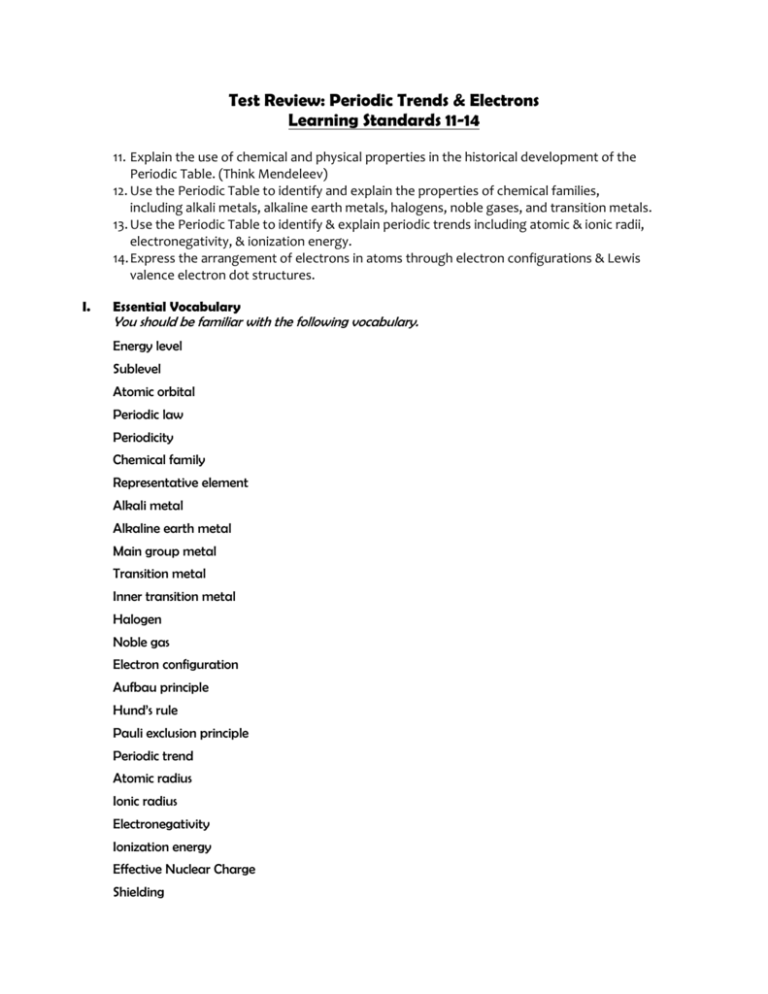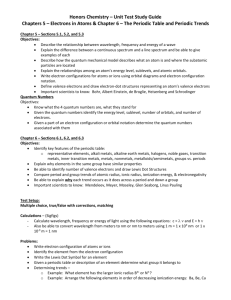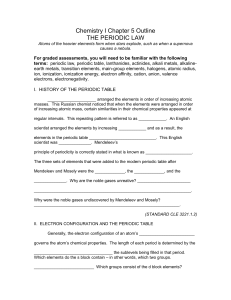III. Periodic Trends
advertisement

Test Review: Periodic Trends & Electrons
Learning Standards 11-14
11. Explain the use of chemical and physical properties in the historical development of the
Periodic Table. (Think Mendeleev)
12. Use the Periodic Table to identify and explain the properties of chemical families,
including alkali metals, alkaline earth metals, halogens, noble gases, and transition metals.
13. Use the Periodic Table to identify & explain periodic trends including atomic & ionic radii,
electronegativity, & ionization energy.
14. Express the arrangement of electrons in atoms through electron configurations & Lewis
valence electron dot structures.
I.
Essential Vocabulary
You should be familiar with the following vocabulary.
Energy level
Sublevel
Atomic orbital
Periodic law
Periodicity
Chemical family
Representative element
Alkali metal
Alkaline earth metal
Main group metal
Transition metal
Inner transition metal
Halogen
Noble gas
Electron configuration
Aufbau principle
Hund’s rule
Pauli exclusion principle
Periodic trend
Atomic radius
Ionic radius
Electronegativity
Ionization energy
Effective Nuclear Charge
Shielding
II.
Periodic Table Basics
1. Who conceived of and created the first periodic table of elements? Dmitri Mendeleev
a. By what two metrics did he arrange the elements in his table?
Increasing atomic mass & similar chemical and physical properties
b. He predicted the discovery of several elements, and even described some of their physical
and chemical properties. Gallium was one of those elements. The predictions that he made
about gallium were based on which element?
Aluminum
2. Classify the following as Metals, Nonmetals, or Metalloids:
a. Potassium
metal
b. Silicon
metalloid
c.
nonmetal
Sulfur
3. Name the group to which the following elements belong (Alkali Metals, Alkaline Earth Metals,
Halogens, Noble Gases):
a. Fluorine
halogen
b. Magnesium
alkaline earth metal
c.
noble gas
Argon
d. Cesium
alkali metal
4. To what larger category does each of the following elements belong? {Representative
Elements, Transition Metals, Inner Transition Metals}
a. Uranium
inner transition metal
b. Carbon
representative element
c.
transition metal
Iron
5. How many energy levels contain electron for the following neutral atoms?
(Occupied energy level = period number)
a. Helium
1
b. Zinc
4
c.
3
Aluminum
6. How many valence electrons are found in neutral atoms of the following elements?
(Valence electrons = group number)
a. Phosphorus
5
b. Bromine
c.
Lithium
d. Boron
7
1
3
7. How are elements with similar properties arranged on the periodic table? In groups/columns
III.
Periodic Trends
8. Define shielding A barrier made of inner-shell electrons which serves to decrease the pull of the
nucleus on the outer electrons.
9. State the trend for shielding
a. Across a period Constant
b. Down a group Increases
10. Define atomic radius
The size of an atom. Half the distance between two nuclei in a
diatomic molecule.
11. State the trend for atomic radius
a. Across a period Decreases
b. Down a group Increases
12. Explain the trends for atomic radius at the atomic level.
Across a period there are more
protons (Zeff – effective nuclear charge) pulling on the same number of energy levels. Down a
group there are more energy levels and more shielding so the outermost electrons aren’t held
as tightly.
13. Define electronegativity
Tendency of an atom to attract BONDED electrons closer to
itself.
14. State the trend for electronegativity
a. Across a period Increases
b. Down a group Decreases
15. Explain the trends for electronegativity at the atomic level.
Across a period, more protons
means more attraction. Down a group more energy levels an more shielding means less
attraction.
16. Define ionization energy
Amount of energy required to remove an electron.
17. State the trend for ionization energy
a. Across a period Increases
b. Down a group Decreases
18. Explain the trends for ionization energy at the atomic level
Across a period more protons
mean more attraction making it more difficult to remove an electron. Down a group more
energy levels and more shielding means the outer electrons aren’t held as tightly, therefore it
takes less energy to remove.
19. Define reactivity
How easily a metal atom loses its electrons or how easily a non-metal
atom gains electrons.
20. State the trend for reactivity of metals
a. Across a period Decreases
b. Down a group Increases
21. State the trend for reactivity of nonmetals
a. Across a period Increases
b. Down a group Decreases
22. Explain the trends for reactivity at the atomic level.
Since metals lose electrons in chemical
reactions, those atoms that can easily lose electrons (low ionization energy) are most reactive.
Since non-metals gain electrons in chemical reactions, those atoms that can easily gain
electrons (high electronegativity/electron affinity) are most reactive.
23. How does the ionic radius of a metal cation compare to its neutral atom? Explain. Smaller,
goes down an energy level.
24. How the ionic radius of a nonmetal anion compare to its neutral atom? Explain.
Larger,
more electron repulsion.
25. Arrange the following ions in order of increasing size.
a. K +, Fe +3, Ca +2, Se -2, Mn +7, Br –
Mn +7, Fe +3, Ca +2, K +, Br –, Se -2
b. Al +3, Cl -, K +, Ca +2, Si +4, P -3
Si +4, Al +3, Ca +2, K +, Cl -, P -3
IV.
Electron Configuration
26. Define principle energy level/quantum number. How is principle energy level related to
position on the periodic table? Region around the nucleus where an electron is likely to be
moving. It is related to the period number.
27. How many and what type of sublevels are in each principal energy level?
a. 1
1
s
b. 2
2
s,p
c.
3
3
s,p,d
d. 4
4
s,p,d,f
e. 5
5
s,p,d,f,g
f.
6
6
s,p,d,f,g,h
g. 7
7
s,p,d,f,g,h,i
28. How many orbitals can be found within each sublevel?
a. s
1
b. p
3
c.
d
5
d. f
7
29. How many electrons can be found within a single orbital?
30. How many electrons can be found within each sublevel?
2
a. s
2
b. p
6
c.
d
10
d. f
14
31. How many electrons can be found within each principal energy level?
a. 1
2
b. 2
8
c.
3
18
d. 4
32
32. What is the shape of an s orbital?
spherical
33. What is the shape of a p orbital?
dumbbell
34. What is the shape of a d orbital?
clover-leaf
35. Define Aufbau principle Electrons enter orbitals of lowest energy first
36. State the Pauli Exclusion Principle. In a particular atom, no two electrons can have the same
set of four quantum numbers
37. State Hunds Rule. The most stable electron arrangement maximizes the number of unpaired
electrons (each electron gets its own room before pairing)
38. Write unabbreviated and abbreviated electron configurations of neutral atoms:
a. V
1s22s22p63s23p64s23d3
[Ar]4s23d3
b. C
1s22s22p2
[He]2s22p2
c.
1s22s22p63s23p64s23d104p65s1
[Kr]5s1
Rb
39. For each of the atoms in #17, identify the energy level of the highest energy electrons.
a. 3
b. 2
c.
5
40. For each of the atoms in #17, identify the energy level of the OUTERMOST electrons.
a. 4
b. 2
c.
5
41. Write and explain the advantage of exceptional electron configurations:
a. Ag
[Kr]5s14d10
full d sublevel is more stable
b. Cr
[Ar]4s13d5
minimizes electron repulsion
42. Identify atoms based on their electron configurations:
a. 1s22s22p63s23p1
2
2
6
2
6
Al
2
6
b. 1s 2s 2p 3s 3p 4s 3d
Fe
43. Write electron configurations for ions:
a. Ca2+
[Ne]3s23p6
b. Br1-
[Ar]4s23d104p6
c.
Ni2+
[Ar]3d8
44. Define valence electrons. How is the number of valence electrons for the representative
elements related to position on the periodic table? Electrons in highest occupied energy level.
Same as group number.
45. Define octet rule. In forming compounds, atoms tend to achieve the electron configuration of a
noble gas.
46. How can electron configurations and position on the periodic table be used to predict the
charges on ions (particularly for the representative elements)? Atoms gain or lose electrons to
get 8 in the outermost energy level. Metals usually lose electrons and go down an energy level.
Nonmetals usually gain electrons to get eight in the outermost energy level.
47. Define isoelectronic. Atoms or ions with the same number of electrons/electron configuration.
48. How do transition metals usually form ions? Lose highest numerical energy level first before
lower numbered d.
49. Write non-core orbital notation for atoms and ions in #17, and #20-22.
50. Define cation and anion. Cation = positively charged ion, Anion = negatively charged ion







